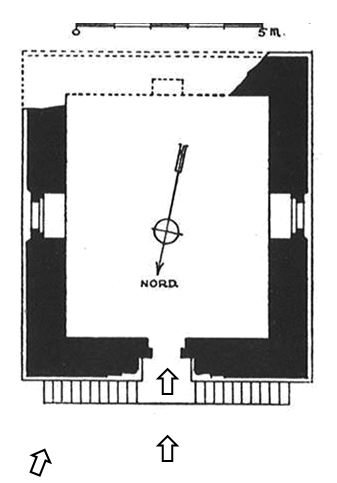Zarifa Alikperova
The tomb of Amir ‘Ali Pishraw in Kayseri is a rectangular building which measures about 8.6 x 7.4 metres. Made of cut stone, it is dated to 1350, corresponding to the year that Kayseri was ruled by the Eretna dynasty (1335-81). The tomb has two storeys comprising a chamber and a crypt that characterize a number of funerary structures built in medieval Anatolia.
The main entrance to the tomb faces the north. It is set in a rectangular niche and is approached by a high double staircase. Two slender columns flank the entrance, one on each side. A muqarnas vault crowns the top of the entrance, which is surmounted by a blind pointed arch. At the apex of that arch is a marble plaque with a carved dedicatory inscription in Arabic written in thuluth script. Referring to the tomb as a mashhad, usually used to indicate the burial of a holy figure or a site of religious visitation, the inscription mentions Amir ‘Ali Pishraw and the year 751 [1350], which is the date of the construction of the tomb.
هذا مشهد الامير علي پيشرو 1.
في سنة احد و حمسين و سبعماية 2.
The interior of the chamber is barrel vaulted. It is lit by three small rectangular windows that are placed on the western, eastern and southern walls of the tomb. Just opposite the entrance is a mihrab niche, indicating the direction to Mecca to which Muslims turn in prayer. Previously, the chamber had two marble cenotaphs. By the late twentieth century, the cenotaphs were moved to the Kayseri Archaeological Museum, however. Both cenotaphs are inscribed with verses from the Qur’an (II: 255-256). Moreover, the two carry text about the deceased figures. While the name of the deceased on the cenotaph which is inscribed with the date 753 [1353] is damaged, that inscribed on the other cenotaph reads Amir ‘Ali, son of ‘Umar. In addition, the inscription on the latter cenotaph reveals that Amir ‘Ali was known as Pishraw (meaning ‘chief’ in Persian) and died in 750 [1349]. This implies that the tomb, which is dated to 751/1350 in the dedicatory inscription, was built after the death of Amir ‘Ali Pishraw.
Inscription on the upper part of the cenotaph:
هذا قبر الامير المرحوم السعيد علي بن عمر المعروف پيشرو رحمة الله
Inscription on the lower part of the cenotaph:
توفى في نصف شهر رمضان المبارك سنة حمسين و سبعماية
A crypt is located below the chamber of the tomb. Access to it is provided by a door located under the double staircase of the front façade. Like the chamber, the crypt is barrel vaulted. However, it is dark as there are no windows to provide light. Moreover, the crypt is empty and there is no information about the bodies which were buried there in the past.
Interactive Plan

Image Gallery
Bibliography
Bates, Ü. Ü. ‘The Anatolian Mausoleum of the Twelfth, Thirteenth, and Fourteenth Centuries’, Unpublished PhD dissertation (University of Michigan, 1970), 179-180.
Cirtil, S. ‘Emir Ali Pişrev Türbesi’, Kayseri Ansiklopedisi, Cilt 2 (Kayseri, 2010), 151-152.
Edhem (Eldem), H. Kayseri Şehri-Selçuklu Tarihi’nden Bir Bölüm. K. Göde, ed. (Ankara, 1982), 142.
Gabriel, A. Monuments Turcs D’Anatolie. Kayseri-Niğde. Ed. Nezih Başgelen (Istanbul, 1989), 82.
Inscriptions
- Çayırdağ, M. ‘Emir Ali Bey’, Kayseri Ansiklopedisi, Cilt 2 (Kayseri, 2010) 149-151.
- Erkiletlioğlu, H. Kayseri Kitabeleri (Kayseri, 2001), 93.


